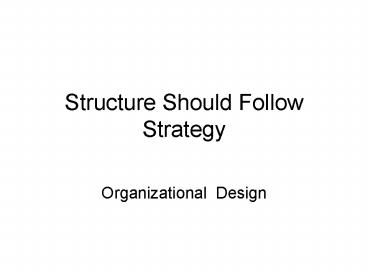Structure Should Follow Strategy - PowerPoint PPT Presentation
1 / 17
Title:
Structure Should Follow Strategy
Description:
Demands too great for one individual. Firm diversifies its ... The new structure is ... included product development and purchasing to provide a seamless ... – PowerPoint PPT presentation
Number of Views:52
Avg rating:3.0/5.0
Title: Structure Should Follow Strategy
1
Structure Should Follow Strategy
- Organizational Design
2
Organizational Structure
- Firms formal reporting relationships,
procedures, controls, and authority and
decision-making processes
3
Controls
- Organizational Controls
- Guide the use of strategy
- Compare actual and expected results
- Suggest corrective actions if unacceptable
- Strategic controls
- Criteria used to verify correct strategy fit with
external and internal factors - Financial Controls
- Criteria to measure performance against
established quantitative standards
4
Wiring Diagrams
- What are they?
- Why use wiring diagrams?
- Important to the company.
- Important to the manager
13-3
5
Shell Organizational Structure
13-2
6
Vertical Differentiation
- Concerned with where decisions are made.
- Where is decision making power concentrated?
- Two Approaches
- Centralization
- Decentralization
13-4
7
Centralization
- Advantages
- Facilitate coordination.
- Consistency of decisions.
- Easier to make changes.
- Avoids duplication.
13-5
8
Centralization
- Disadvantages
- Overburdened top management.
- Motivational research favors decentralization.
Increased motivation at lower levels - Decentralization permits flexibility.
- Decentralization lets decisions be made closer to
the information source. On-the-spot decisions - Decentralization can increase control and
accountability
13-6
9
Horizontal Differentiation
- How a firm divides itself into sub-units - value
creation activities - Demands too great for one individual
- Firm diversifies its product offerings
- Typically function, business area (product) or
geography
10
Development
11
A Typical Functional Structure
Top Management
Purchasing
Manufacturing
Marketing
Finance
Buying units
Plants
Branch sales units
Accounting units
13-10
12
Functional Structure
- Advantages
- CEO in touch with all operations
- Reduces/simplifies control mechanisms
- Clear definition of responsibilities
- Specialists at senior and middle management
levels - Disadvantages
- Overburdened senior managers
- Senior managers neglect strategic issues
- Difficult to handle diversity
- Coordination between functions difficult
- Failure to adapt
13
Typical Product Division Structure
Headquarters
Division product line A
Division product line B
Division product line C
Department Purchasing
Department manufacturing
Department marketing
Department finance
Buying units
Plants
Branch sales units
Accounting units
13-12
14
Multidivisional Structure
- Advantages
- Flexible
- Control by performance
- Ownership of strategy
- Specialization of competences
- Disadvantages
- Additional costs of the center
- Duplication at divisional levels
- Fragmentation and non-cooperation
What would a geographical multidivisional
structure look like?
15
Horizontal DifferentiationGoing Abroad
- Usually firms start with an international
division. - Leads to coordination problems, and
- Conflict between domestic and foreign operations.
13-11
16
International Division Structure
Headquarters
Domestic division General manager Product line A
Domestic division General manager Product line B
Domestic division General manager Product line C
International division General manager area line
Country 1 General manager (product A, B, and /
or C)
Country 2 General manager (product A, B, and /
or C)
Functional units
Functional units
17
Electrolux Home Products EuropeDue February
11No late papers accepted
- In January 2001, Electrolux Home
Products Europe completely realigned its
structure as part of its competitive strategy in
Europe. The Swedish multinational company
manufactured a range of consumer durables such
as cookers and fridges and had grown through
several decades of acquisitions to become a
dominant player in Europe. But the market in
Europe was fiercely competitive and the company
needed to find a way to capitalize on its size
both to reduce costs and also to improve product
and service standards. Its solution was to
introduce a Europe-wide functional structure to
replace the geographical structure (resulting
from its acquisitions). The new structure is
shown here. - The management explained the rationale for the
restructuring the realignment of EHP Europe is
a part of a program to ensure profitable growth
as the organization drives more simplicity into
its business, while reducing the number of
organizational levels, and creating more focus on
area where increased effort is required to meet
the tougher challenges of the marketplace. - The functional departments would operate as
follows - Purchasing, Production, and Product Development
was the manufacturing arm of the business. It
also included product development and purchasing
to provide a seamless flow from supplied to
finished products. This was thought to be
essential to maintaining a stream of innovative
and cost effective products. - Supply Chain Management and Logistics was
responsible for getting products to the customer
and was the link between sales forecasts and
factory production.































